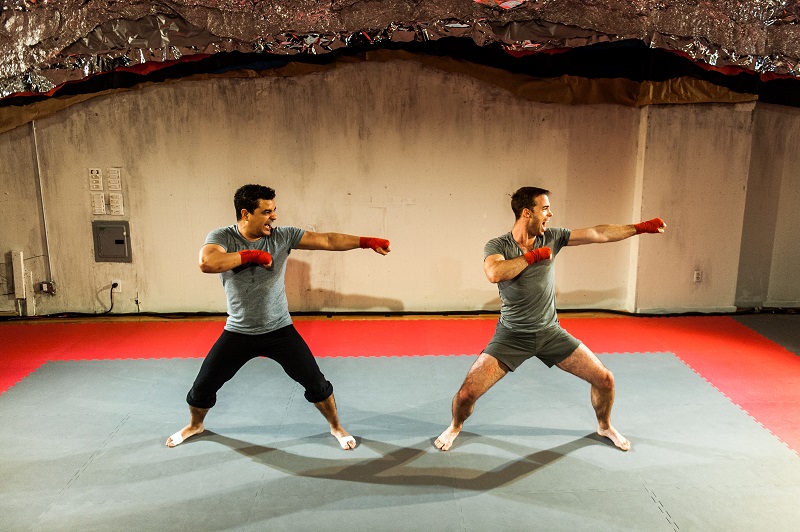
Sweat and Tears is a new piece of physical theater that draws in part of the past experience of creators Jess Goldschmidt and James Rutherford in karate and dance, respectively. These physical pursuits, which can also be viewed as ways of disciplining bodies, inform the play’s presentation of what Rutherford calls in a Theater in the Now interview "extreme acts of gendered labor." The production grew out of what were originally two separate pieces, one by Rutherford that centered around men fighting and one by Goldschmidt constructed around women crying, both of which, Rutherford says, "pulled from a broad swath of performance styles and cultural practices connected to public displays of physical suffering." In bringing these elements together, the non-narrative Sweat and Tears weaves at intervals into its physical displays both original text and text excerpted from poet Matthew Pinnock, Cormac McCarthy's hyper-violent novel Blood Meridian, and Tibetan Buddhist writer Tsangnyön Heruka's biographical Life of Milarepa, asking audiences to interrogate how we perform gendered emotional labor.
The play takes place entirely on bare gym flooring, to which is added a mattress in the second half. Structurally, it retains the male-female divide from its genesis, with the first section performed by Ross Cowan and Casey Robinson as unnamed men who spar with one another. (It may sound odd to say about fighting, but the two actors evince clear chemistry.) As the fighting proceeds, a degree of symmetry becomes apparent, and eventually the events repeat themselves and the fight becomes a kind of refrain, suggestive perhaps of the constraining forms and formulae of masculine emotional interchange. As the fighting repeats, it also modulates, and some of its variations lay bare the constructed nature of the men's interaction, its "fakeness." Occasionally the fight even slips into something other than fighting. It seems noteworthy that each repetition of the repeated fight begins with one performer placing a hand on the other’s shoulder, a gesture that could also be an invitation to connection. In fact, the section’s conclusion features a display of brief, perhaps accidental unity. The verbal spoken components of this portion range in scope and register from the more broadly social to the intimately personal, the latter of which creates a strong contrast between the physical and emotional interactions taking place simultaneously. The textual pieces share themes of mortality, the attempt to do good, game-playing, and risk, some of which connect to a brief game played with the audience to begin the play.
The second half, performed by Jess Myers and Jing Xu, begins with seemingly more sexualized positions. The women play games and fight, like the men do, but while it may be equally performative, the prescriptions for the performance change with the gender. Their interactions also, like the men's, shade into other physicalities. At one point, expressions of upset become a parody of sticking the landing in gymnastic competitions. At another, vocalizations of pleasure and grief become difficult to distinguish. (This section calls a lot of attention to the physicality of the voice.) The second half has a range to its spoken segments similar to that of the first, and they share the theme of mortality, but with much more emphasis on performing mourning, a strain of emotional labor often traditionally coded as female. Similarly to the ending of the first portion, the second features a gesture towards comfort and connection, but it is again short-lived.
Broadly speaking, Sweat and Tears places a binary before the audience and asks us to do some of the interpretive work and question our own adherence to social constructs. The juxtapositions of text to physical display and of one physical display to another leave plenty of room for the viewer to form conclusions regarding what they say about embodied performance and its gendering. The women's half contains more variation and so can be more opaque at times than the male half (not to say that women are more complex or that sorrow is deeper than aggression). Together, these halves add up to a work that is imagistic, physically impressive, at some points funny, and at all points challenging. - Leah Richards & John Ziegler
